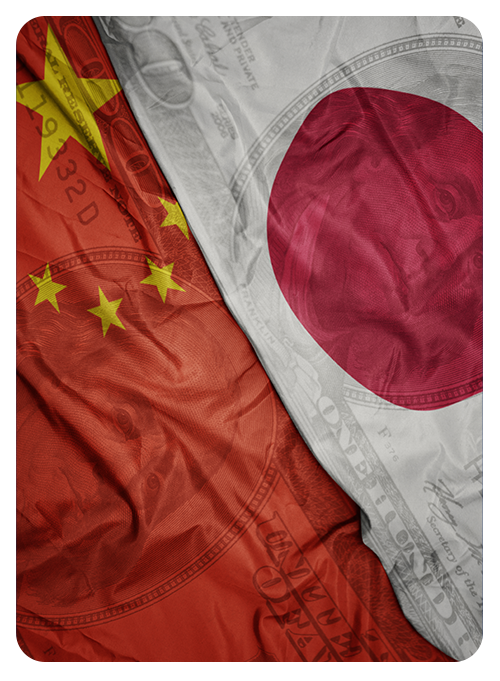Finsphere
India Leads October Market Rally:
Strong growth cues and global trade thaw lift investor sentiment.

Dear Clients and Stakeholders,
Indian equity markets recorded their strongest monthly performance in seven months this October, climbing 4.51% amid growing optimism about the country's economic growth trajectory. Market sentiment was buoyed further, with word on the street suggesting that India and the United States may be close to sealing a trade agreement. Further, the revamped indirect tax structure (GST 2.0), aimed at stimulating demand and promoting fairness, is expected to complement earlier measures such as direct tax and interest rate cuts thereby bolstering domestic consumption —especially amidst easing inflation.
President Donald Trump’s hostile tariff stance took a more constructive turn as his visit to the Asia helped reinforce strategic trade relationships. The US and Japan signed an agreement on rare earth mineral cooperation, alongside a joint declaration marking a “new golden age” in bilateral ties, reaffirming the implementation of previously negotiated tariff adjustments, including the 15% tariff framework established earlier this year. Meanwhile, President Trump and South Korea’s President Lee agreed that Seoul would restructure its committed USD 350 billion investment package—USD 200 billion to be disbursed in phased annual tranches of up to USD 20 billion, with the remaining USD 150 billion allocated toward shipbuilding investments, in line with US industrial revival priorities.
However, the most consequential leg of President Trump’s trip was his meeting with President Xi Jinping in South Korea. The two countries, which have maintained an uneasy trade truce, took incremental steps toward easing tensions. The US agreed to reduce the additional fentanyl-linked duties on Chinese imports to 20%, effectively lowering the aggregate US tariff burden on Chinese goods to 47% from 57%. In return, China agreed to delay by a year its recently announced export controls on rare earth minerals and high-strength magnets—materials critical to aerospace, automotive, and defense manufacturing—which have been central to Beijing’s strategic leverage in trade negotiations.
Domestically, the US government shutdown has now entered its sixth week and risks surpassing the 35-day record set in 2019. The current impasse over budget, shows few signs of near-term resolution and has begun to raise concerns regarding near-term federal spending.
Despite these headwinds, improving geopolitical signals and stronger-than-expected technology sector earnings supported US equity market performance through October. By month-end, the Dow Jones had gained 2.51% W/W (YTD +11.80%), the S&P 500 rose 2.27% (YTD +16.30%), while the tech-heavy Nasdaq outperformed with a 4.7% increase (YTD +22.86%). The Russell 2000 lagged, declining 3.3% (YTD +11.18%).
United States
Fed delivers rate cut as expected but maintains cautious tone on further easing
The Federal Reserve lowered the federal funds rate by 25 bps to a target range of 3.75%–4.00% at its October 2025 meeting, in line with expectations and following a similar cut in September. This brings borrowing costs to their lowest level since 2022. Policymakers cited rising downside risks to employment, even as inflation has edged higher compared to earlier in the year. However, Inflation rate for September despite at its highest since January subverted expectations, rising 3.0% YoY in September The policy statement also acknowledged that the ongoing government shutdown has begun to limit the availability of official economic data, with Chair Powell noting that the Fed may adopt a more cautious approach should data flow remain constrained.
Housing data presented a mixed picture: lower mortgage rates supported demand, yet softer labour market conditions remained a headwind. Existing home sales rose 1.5% MoM to the highest level in seven months, and home prices increased 0.4% MoM in August, the strongest gain this year. However, pending home sales remained unchanged MoM in September, missing expectations of a 1.6% rise and indicating a slowdown in pipeline sale.
Overall, while the US economy continues to exhibit resilience, the combination of tariff-related inflation risks, a gradual cooling in labour market conditions, and uncertainty tied to the prolonged government shutdown has led the Fed to adopt a measured stance.


Eurozone & UK
Disinflation progress amid uneven industrial recovery
In the Euro Area, headline inflation eased back to 2.1% in October, moving closer to the ECB’s target range, however, core inflation remained stable at 2.4%. On the producer side, Euro area PPI for September fell 0.1% MoM, pointing to moderating pipeline cost pressures. Industrial activity remained soft, with industrial production down 1.2% MoM in August, underscoring fragile underlying momentum in manufacturing activity. Meanwhile, Eurozone GDP grew 1.3% YoY in Q3, down from 1.5% in Q2, but slightly ahead of expectations.
Labour markets stayed resilient, with the unemployment rate steady at 6.3%, although youth unemployment edged up to 14.4%, indicating early signs of softening demand for fresh hires. The ECB held policy rates steady for the third consecutive meeting, reiterating that policy settings remain consistent with achieving medium-term inflation goals and that further decisions will be dependent on domestic demand and trade conditions. On the trade front, trade surplus fell to €1.0 billion in August 2025 as exports fell 4.7% and imports fell 3.8%.
In the UK, underlying momentum remained mixed. Retail sales rose 0.5% MoM in September, marking a fourth consecutive monthly gain and bringing sales to their highest level since mid-2022.
Industrial production rose marginally by 0.4% MoM in August while labour markets showed further signs of softness as the unemployment rate rose to 4.8% in the three months to August — the highest since mid-2021. On the trade front, Britain’s goods exports declined 3.6% weighed down by a 5.3% drop in shipments to EU and 1.5% drop in shipments to non-EU countries.
Overall, both the European Central Bank (ECB) and the Bank of England (BoE) remain in a wait-and-watch stance, as industrial sluggishness, tepid labor market conditions, and falling exports persist. Meanwhile, France—the EU’s second-largest economy—is grappling with political turbulence, highlighted by the reappointment of Mr. Sebastien Lecornu, who had resigned less than a month into office, amid ongoing cabinet tussle over the national budget.
Asia
Japan’s soft labour market weighs demand outlook; China shows signs of stabilization under policy support.
In Japan, inflation which had reached a 10-month low of 2.7% in August, rose 2.9% YoY in September while producer prices rose 2.7% YoY as costs continued to rise for most components. Labour market continued to remain soft as real wages fell for the eighth consecutive month in August while unemployment held firm at 2.6% in September – the highest since July 2024. Industrial production rebounded in September gaining 2.2% MoM while retail sales rose 0.5% YoY. Meanwhile, Japan’s trade deficit decreased to JPY 3.778 billion in August - the largest since February – as imports fell 6% and exports declined 0.4%.
In China, GDP grew 1.1% QoQ in Q3FY25 indicating gradual stabilization in the economy showed as the government continues to deploy supportive policy measures. Industrial production accelerated to 6.5% YoY in September, driven by automotive, electronics, and shipbuilding output. However, retail sales growth slowed to 3.0% YoY, reflecting cautious consumer sentiment.

Disinflationary conditions persisted with CPI falling 0.3% YoY, however, core inflation rose modestly to 1.0%, indicating benign costs amid tepid demand. Unemployment eased slightly to 5.2% from August’s six month high of 5.3%. The PBoC maintained lending rates unchanged for the fifth consecutive month and continued liquidity injections to stabilize short-term funding markets.
Japan and China are undergoing significant shifts in their respective policy landscapes. In Japan, the appointment of Ms. Sanae Takaichi has reignited optimism around a potential return to expansionary economic measures, with recent negotiations further bolstering confidence among market participants. Meanwhile, China, grappling with a slowdown in domestic demand, is looking towards policy stimulus and improved trade prospects with the United States to spur its economy.

India’s Economic Pulse:
Domestic resilience continues, though external pressures widen trade gap.
India’s economic activity remained broadly resilient through September, supported by steady manufacturing momentum and firm domestic demand conditions. Industrial Production (IIP) rose 4% YoY in September, though slightly lower than August’s 4.12%. Meanwhile, the eight core sectors grew 3% in September a sharp decline from 6.5% in August as energy related sectors weighted on performance. Inflation continued to remain benign, with CPI falling to 1.54% in September, driven primarily by a significant decline in food prices while core inflation remained broadly stable. Wholesale inflation (WPI) also cooled to 0.13%, aided by corrections in primary food articles and crude oil, even as manufactured product prices stayed steady. Meanwhile, unemployment rate for September witnessed a marginal uptick to 5.2% following two consecutive months of declines.
External trade pressures, however, intensified. India’s merchandise trade deficit widened to USD 32.15 billion in September, the largest since November 2024, as imports rose 16.7% to USD 68.53 billion, led by a sharp surge in gold imports ahead of the festive season. Exports increased only 6.1%, weighed by a continued decline in shipments to the US following higher tariff barriers.
However, policy conditions remain supportive. The Reserve Bank of India held the repo rate at 5.50%, maintaining its supportive stance amid easing inflation. The RBI also proposed easing external commercial borrowing norms to broaden access to offshore funding channels and support credit transmission for investment-linked sectors.
Overall, India’s macroeconomic landscape reflects an optimistic trajectory. While questions over growth remain amid global uncertainties and trade pressures, underlying industrial strength, robust domestic demand, and supportive policy measures—such as the introduction of GST 2.0, direct tax rate cuts, interest rate cuts along with a pro-growth stance of the RBI and good monsoon—continue to anchor the economy. Policymakers are likely to maintain their steady approach, providing room for consumption-led growth and infrastructure investment to drive the next phase of expansion.
Conclusion
As we navigate the final two months of 2025, global markets continue to be shaped by improving diplomatic trade relations amid persistent macro uncertainty brought forward by US tariffs. The US faces structural headwinds from tariffs, a cooling labor market, and government shutdown risks, keeping markets on edge. The Eurozone and UK are balancing near-target inflation with soft industrial activity and labor market slack, while Japan and China navigate an evolving policy setting.
In contrast, India stands out for its relative stability. Strong domestic demand, supportive fiscal and monetary policies and moderating inflation provide a resilient foundation for growth. As global uncertainties persist, India’s macroeconomic tailwinds and steady policy approach position the country to sustain momentum, with consumption-led growth and infrastructure investment likely driving the next phase of expansion.
At Chola Securities, we remain steadfast in our commitment to helping you navigate these complexities with clarity and foresight. As always, we aim to align your investments with evolving opportunities while ensuring resilience against emerging headwinds.
We sincerely thank you—our valued clients and investors—for your continued confidence and partnership. Together, we look forward to embracing the challenges and opportunities of the months ahead, ensuring sustained growth and success.
Warm Regards,
N Senthilkumarh
President, Chola Securities
